Video Highlight
The Accumulated Debt and Economic Performance of Industrialized Countries during COVID

Quote Wall: Matt Ridley
Infographic: The Fiscal Costs of Debt-Financed Government Spending
Canadian STUDENT REVIEW
WHAT’S INSIDE FALL 2022 QUARTERLY STUDENT MAGAZINE 2022 ESSAY CONTEST WINNERS WHAT IN THE WORLD WOULD ADAM SMITH SAY?
EDITOR Ryan Hill
LAYOUT AND DESIGN Carolina Wong
PRODUCTION EDITOR Kristin McCahon
PHOTO CREDITS iStock, Pexels

To receive a subscription, or to write to us about articles you read in this publication, contact us at:
Canadian Student Review 1770 Burrard Street, 4th Floor Vancouver, British Columbia V6J 3G7
TEL 604.688.0221 ext. 538 FAX 604.688.8539
EMAIL Ryan.Hill@fraserinstitute.org
Copyright © 2022, the Fraser Institute
DATE OF ISSUE Fall 2022
ISSN 1707-116X (online edition)
Canadian Student Review is sponsored by the Lotte & John Hecht Memorial Foundation.
Canadian Student Review is published by the Fraser Institute. The views contained within are strictly those of the authors.
Our mission is to improve the quality of life for Canadians, their families and future generations by studying, measuring and broadly communicating the effects of government policies, entrepreneurship and choice on their well-being.
FRASERINSTITUTE.ORG | CANADIAN STUDENT REVIEW2
Canadian STUDENT REVIEW
TABLE OF CONTENTS
4 . . . . .
5 . . . . .
9 . . . . .
Welcome Message
Student Essay Winner - Graduate
Video Gallery
This video highlights Canada’s accumulated debt and economic performance against other industrialized countries during the pandemic.
10 . . . .
Student Essay Winner - Undergraduate
14 . . . . Infographic
This recent infographic breaks down the consequences of Canada’s accumulated debt.
15 . . . .
19
Student Essay Winner - High School
The Fraser Institute Blog
In this short commentary, Alex Whalen provides his case for privatizing the Nova Scotia Liquor Corporation.
21 . . . . Quote Wall
A quote by Matt Ridley from his book, The Rational Optimist: How Prosperity Evolves

22 . . . .
24
The Fraser Institute Blog
This primer breaks down the complicated concept of inflation.


. Webinars
.
Our Explore Public Policy Issues webinars are available on demand. Check out our recorded webinars here

.
.
FALL 2022 5 10 15 21 FALL 2022 3
WELCOME
Dear Readers,
I hope that you had a wonderful summer and that you are excited about the transition into the next phase of your academic career or new semester.
In this edition of the Canadian Student Review, we highlight the winners of the 2022 Essay Contest. We received several hundred submissions in which students discussed the ideas of Adam Smith and applied his way of thinking to a current public policy issue of their choosing.
We have also included primer on inflation to better explain this topical issue, a quote from Matt Ridley, and some other interesting policy commentaries that you won’t want to miss. Finally, we’ve included two of our most recent Explore Public Policy Issues webinar series recordings for your enjoyment.
If you or someone you know wishes to contribute content to the Canadian Student Review, please have them contact Ryan Hill directly at Ryan.Hill@fraserinstitute.org. Best, Ryan

FRASERINSTITUTE.ORG | CANADIAN STUDENT REVIEW4
THE WEALTH OF THE GIG NATION ISABELLA GIANCOLA
Introduction
The year is 2008. Triggered by a collapse in the United States’ real estate market, the world is experiencing the largest economic decline since the Great Depression of 1929. In Canada, 400,000 jobs were lost (Statistics Canada, 2010) and in America, 8.9 million (Center on Budget and Policy Priorities, 2019). Yet out of the ashes of the aching global economy emerged two titans of modern business and a revolutionary way to outsource commerce to the populace: Airbnb, Uber, and the gig economy.
Airbnb and Uber reinvigorated the modern marketplace with a flair reminiscent of economics’ most lauded thinker, founding father of modern economic thought and free market capitalism, Adam Smith. Like Smith, they champion the powerful potential of the free market by ensuring a competitive market that is free in nature by using a pricing scheme based on market forces.
A brief history of Airbnb and Uber Airbnb launched in 2008 with a simple but ingenious idea—to provide a platform for homeowners to rent spare spaces in their dwellings to travelers, bypassing the traditional expenses and constraints of a hotel and providing a more immersive, memorable, and economical experience (Aydin, 2019). Today, Airbnb has over 6 million listings in over 220 countries and regions, has served over 4 million guests, and earned more than $150 billion for their 4 million hosts (Airbnb Newsroom, 2022). In a similar vein, Uber, launched in 2009, enables users to call up rides from everyday drivers via their mobile phones, skipping the unpredictability and priciness of hailing
a cab (Uber Newsroom, 2022). Today, Uber boasts 93 million riders served by 3.5 million drivers (Georgiev, 2022). The company was valued at approximately $46 billion in 2020 (Georgiev, 2022). Both firms formed the cornerstone of the blossoming gig economy, employing over 1.7 million Canadians prior to 2020 (Statistics Canada, 2022).
Free-market competition
In his 1776 magnum opus, An Inquiry into the Nature and Causes of the Wealth of Nations, Adam Smith argued that, “in general, if any branch of trade, or any division of labour, be advantageous to the public, the freer and more general the competition, it will always be the more so” (Smith, 1776/2003). To Smith, “[competitive] consumption is the sole end and purpose of all production” (Smith, 1776/2003). When they face competition and have the freedom to enter and leave the market, firms have an incentive to provide consumers with a quality product. When they are serving a consumer base that has no choice and are enjoying unchallenged market dominance, they become complacent. Only with free competition does the market operate efficiently.
Both Airbnb and Uber outsource their central products to their hosts and drivers, allowing individuals to voluntarily sign up for their services with an effective but limited vetting process, forgoing the traditional resume followed by an interview. Hosts and drivers enter the market prepared to compete. Both companies provide a platform, support, and, by virtue of their mammoth platforms, the power to reach millions of eager consumers. Both platforms only collect money after a reservation has been made
STUDENT ESSAY WINNER - GRADUATE FALL 2022 5
or a drive has been booked. In this way, hosts and drivers operate in a free and democratic market. They compete based on the quality of their service— predominantly measured by ratings and reviews— unencumbered by advertising costs that favour the already-wealthy. They must actively work to provide a clean, renovated, and well-photographed space, and drive with efficiency, safety, and care. Should they perform insufficiently, their service will be drowned out, leaving only the most effective workers—in both price and quality—to serve consumers while better prepared competitors enter the market in their place.
Market-based pricing
In The Wealth of Nations, Adam Smith also wrote that “the market price of every particular commodity is regulated by the proportion between the quantity which is actually brought to market, and the demand of those who are willing to pay” (Smith, 1776/2003). Particularly, that prices should be determined by the competitive forces of the free market itself (Smith, 1776/2003)
1 As of June 5th, 2022.
Characteristic of the gig economy, both Airbnb and Uber exploit variable or surge pricing, a scheme wherein the price of a room or ride is closely intertwined with supply, demand, and the factors that contribute to them. Airbnb allows their hosts to price their accommodations as they see fit. For some, this could mean a flat fee of, for example, $150 a night, constant in both August and January. Others find that this strategy ignores both supply and demand. Each customer’s willingness to pay for a room is conditional on a matrix of variables: the time of the year, the day of the week, the space’s location, size, and decor, and the amenities and other housing options that surround it. Exploiting their trove of market data, Airbnb allows hosts to use its service to algorithmically determine the price of their room, which ensures it is priced optimally according to the market in which it exists (Airbnb Resource Center, 2019). For Uber, prices are also algorithmically determined, rising in times of inclement weather, during events, or in rush hour when the number of riders exceeds the number of available cars (Uber, 2022). Importantly,

FRASERINSTITUTE.ORG | CANADIAN STUDENT REVIEW6
both pricing strategies are heavily market-based, emphasizing competitive forces and extracting all possible information from them through big data and sophisticated algorithms.
Consider Airbnb’s presence in Toronto, Canada. According to variable pricing, a space’s price should be inversely proportional to its distance from the city centre—those closer to the centre should be priced higher. Figure 1 visualizes Toronto’s 15,171 listings1 both geospatially (Panel A) and graphically (Panel B). Panel A shows a larger concentration of Airbnb listings in Toronto’s downtown core, tapering off in the suburbs. As such, there is more competition,

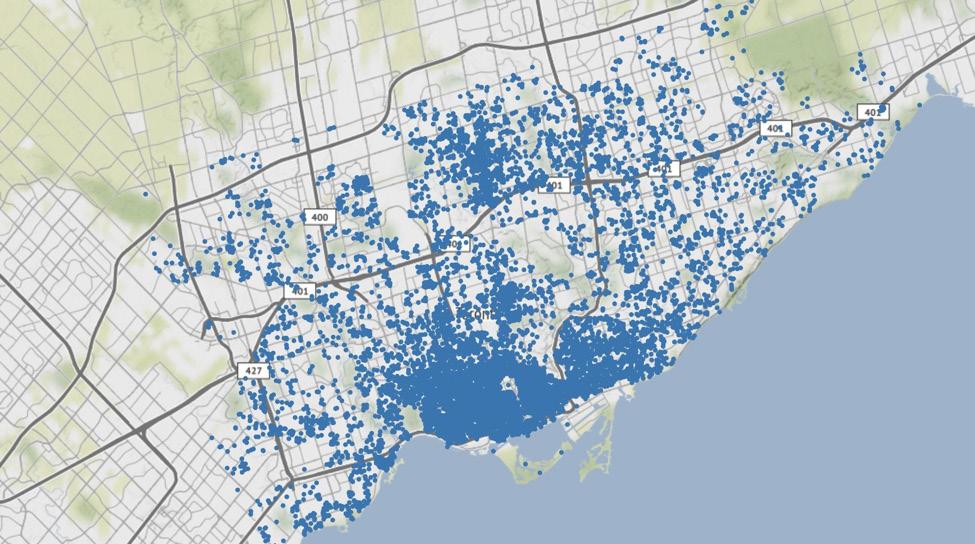
reflective of higher demand, in the downtown core. Panel B shows that the strength of demand is enough to counterbalance the negative price pressure caused by higher supply, presenting a negative correlation: the closer a listing is to the city centre, the higher its price, on average. In other words, Smith’s marketbased pricing is at work.
Conclusion
As the world recovers from the effects of the COVID-19 pandemic, the free-market power of the gig economy generally and Airbnb and Uber specifically is more important than ever. By April 2020, Canada had lost 2 million jobs since the start of the pandemic, a
Figure 1: TORONTO AIRBNBS2
2 Figures were manually generated using data from Inside Airbnb from June 5th, 2022: http://insideairbnb.com/get-the-data
PANEL A: GEOSPATIAL DISTRIBUTION OF AIRBNBS
PANEL B: DISTANCE AND PRICE OF AIRBNBS
FALL 2022 7
figure that continued to climb steadily in the months afterward (Johnson and Ljunggren, 2020). In this time of crisis, Canadians turned to the free market in the form of the gig economy to support themselves. Approximately 1 in 10 Canadians report receiving some or all of their employment in the gig economy, over 900,000 joined in response to the effects of the pandemic, and 8.9 million Canadians expressed an openness to participate in it (H&R Block Canada, 2022). Adam Smith’s beloved free market offers opportunities for wealth and success. It is what we turned to in times of need and what will propel us out of economic stagnation into prosperity.
Isabella Giancola is currently pursuing her MA in Economics at Columbia University, and is a recent graduate from the University of Toronto where she earned an Hons. BA in Economics with a focus in data analytics. Isabella is interested in applied microeconomics and econometrics, and aspires to a career in economic research.

REFERENCES
Airbnb Newsroom (2022). About Us. Airbnb. <https://news.airbnb.com/about-us/>, as of August 23, 2022.
Airbnb Resource Center (2019, October 7). Adjusting Your Price and Settings to Meet Local Demand. Airbnb. <https://www.airbnb.ca/resources/hosting-homes/a/adjusting-yourprice-and-settings-to-meet-local-demand-48>, as of August 23, 2022.
Aydin, Rebecca (2019, September 20). How 3 Guys Turned Renting Air Mattresses in Their Apartment into a $31 Billion Company, Airbnb. Business Insider https://www. businessinsider.com/how-airbnb-was-founded-a-visual-history-2016-2>, as of August 23, 2022.
Center on Budget and Policy Priorities (2019). Chart Book: The Legacy of the Great Recession. [United States] Center on Budget and Policy Priorities. <https://www.cbpp.org/ research/economy/the-legacy-of-the-great-recession>, as of August 23, 2022.
Georgiev, Deyan (2022, August 19). 51+ of the Best Uber Statistics and Facts to Know in 2022. Techjury. <https://techjury.net/blog/uber-statistics/#gref>, as of August 23, 2022.
H&R Block Canada (2022, April 11). Gig Economy Workforce Rockets to More Than One in Ten of Canadians; a Further Third Are Open to Joining, Reveals New Study. Cision. <https:// www.newswire.ca/news-releases/gig-economy-workforce-rockets-to-more-than-one-in-ten-of-canadians-a-further-third-are-open-to-joining-reveals-new-study-812441559.html>, as of August 23, 2022.
Johnson, Kelsey, and David Ljunggren (2020, May 8). Canada Loses Record 2 Million Jobs, Ottawa Extends Costly Wage Subsidy Program. Reuters. <https://www.reuters.com/article/ us-canada-economy-employment-idUSKBN22K1P1>, as of August 23, 2022.
Smith, Adam (1776/2003). The Wealth of Nations. Edwin Cannan and Alan B. Krueger (eds.). Bantam Classic.
Statistics Canada (2010). Canada’s Employment Downturn. Statistics Canada. <https://www150.statcan.gc.ca/n1/pub/75-001-x/2009112/article/11048-eng.htm>, as of August 23, 2022. Statistics Canada (2022, January 14). The Changing Nature of Work. Statistics Canada. <https://www.statcan.gc.ca/o1/en/plus/249-changing-nature-work>, as of August 23, 2022.
Uber (2022). How Surge Pricing Works. Uber. <https://www.uber.com/us/en/drive/driver-app/how-surge-works/>, as of August 23, 2022.
Uber Newsroom (2022). The History of Uber. Uber. <https://www.uber.com/en-CA/newsroom/history/>, as of August 23, 2022.
FRASERINSTITUTE.ORG | CANADIAN STUDENT REVIEW8
THE ACCUMULATED DEBT AND ECONOMIC PERFORMANCE OF INDUSTRIALIZED COUNTRIES DURING COVID
THIS VIDEO HIGHLIGHTS CANADA’S ACCUMULATED DEBT AND ECONOMIC PERFORMANCE AGAINST OTHER INDUSTRIALIZED COUNTRIES DURING THE PANDEMIC.

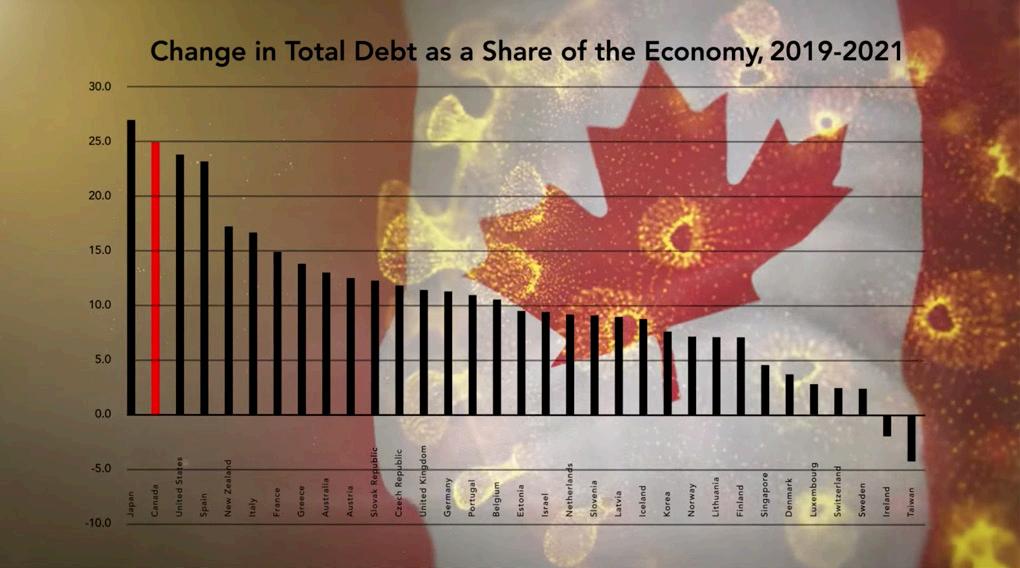
WATCH VIDEO HERE

VIDEO GALLERY
FALL 2022 9
A SMITHIAN VIEW OF COVID-19 AND CANADA’S PUBLIC DEBT ALLISON KNEE
An issue of great socioeconomic significance today is Canada’s public debt, both provincial and federal. Canadian federal debt has ballooned to over $1.1 trillion during the course of the ongoing COVID-19 pandemic (Statistics Canada, 2022). The purpose of this essay is to analyze whether this public debt is reasonable, or if it signals fiscal irresponsibility and a subsequent need for change. More specifically, this essay includes an application of the ideas of Adam Smith, the founding father of economics, to infer what he would have thought of how the government is currently handling Canada’s public debt situation, and how he might have suggested managing it differently (Smith, 1776/1904; Otteson, 2018).
Public debt is defined as the accumulated total of all government liabilities from raising funds to finance government expenditures through issuing bonds or other securities (Bird and Smart, 2006). Fiscal deficits are the yearly imbalances between government spending and revenues; if spending exceeds revenue, a budget deficit exists, which is added to existing public debt. Adam Smith, famous for his belief in a free and fair market system with little government intervention, included a chapter regarding public debts in his 1776 classic, The Wealth of Nations. In this chapter, Smith discussed the prevalence of public debt in European nations, specifically its distribution and its apparent effects in those nations. Consistent with his stance on government intervention in markets, Smith disapproved of too much outstanding public debt, because an overaccumulation of public debt would have negative consequences for economies, such as bankruptcy, among others (Smith, 1776/1904: 415). Smith further argued that at a certain point
taxes become difficult to increase and are met with opposition by taxpayers; he discussed the concept of a “sinking fund” for paying off debt, but showed that such a fund was mostly misapplied to other expenses as a way to avoid raising taxes further:
When a nation is already overburdened with taxes, nothing but the necessities of a new war, nothing but either the animosity of national vengeance, or the anxiety for national security, can induce the people to submit, with tolerable patience, to a new tax. Hence the usual misapplication of the sinking fund. (Smith, 1776/1904: 406)
Smith’s ideas remain relevant in Canada today as government debt and tax rates are high, both historically and internationally. For instance, Canada’s total tax revenue soared from 25 percent of its GDP in 1965 to 34.4 percent of GDP in 2020, higher than the OECD average of 33.5 percent for the same year (OECD, 2021a). Similarly, Canada’s general government gross debt rose considerably from 70.6 percent in 2007 to 92.7 percent in 2019, compared with the 2019 OECD average of 79.9 percent (OECD, 2021b). Despite these trends, some governments today still view deficits as generally acceptable, and therefore use available funds—government income and tax revenues—for other purposes, for example fiscal stimulus or porkbarrel projects, that could otherwise be allocated to lessening the national debt. In contrast, Smith argued that the accumulation of public debt is inherently undesirable and paying off this accumulation is of utmost importance, as evidenced by his assurances that funds put aside for servicing this debt should not be used for other purposes. Some governments
STUDENT ESSAY WINNER - UNDERGRADUATE
FRASERINSTITUTE.ORG | CANADIAN STUDENT REVIEW10
today still maintain sinking funds for the repayment of public debt (one of which is Newfoundland & Labrador), and for those governments that typically do not have sinking funds for servicing debt, Smith’s ideas mean that their budget surpluses, whenever available, should be earmarked for the repayment of debt. Smith emphasized the importance of reducing outstanding public debt this way:
The more the public debts may have been accumulated, the more necessary it may have become to study to reduce them, the more dangerous, the more ruinous it may be to misapply any part of the sinking fund; the less likely is the public debt to be reduced to any considerable degree, the more likely, the more certainly is the sinking fund to be misapplied towards defraying all extraordinary expenses which occur in time of peace. (Smith, 1776: 406).
Today, Canada’s accumulated federal debt is estimated at $1.1 trillion, in addition to further projected annual government deficits, which contradict the concept of lessening this debt and maintaining a balanced budget (Statistics Canada, 2022). During the global COVID-19 pandemic,
government spending increased in order to fund emergency support measures, such as the Canada Emergency Response Benefit (CERB), on which $74.08 billion was spent alone (Canada, 2022). This increase in spending combined with the pandemic’s adverse effects on business revenues had the effect of increasing federal debt from $697 billion in 2019, to $974 billion in 2020, and to $1,117 billion in 2021 (Statistics Canada, 2022). As Figure 1 shows, there was a noticeably large spike in the Canadian federal debt corresponding to the respective years of the pandemic’s influence. An important and pressing issue is how and if this spike can be reduced over time as the debt is ultimately paid off.
It is important to note that debt accumulation is a pressing issue not only at the federal level, but also at the provincial level across Canada. Debt-to-GDP ratios are commonly used to show the depth and significance of outstanding public debt relative to the national income of an economy; high debt-toGDP ratios signify a heavier debt burden on citizens and taxpayers. Figure 2 shows that the pandemic had the effect of raising net debt relative to GDP in all 10 provinces, thus raising future debt burdens to varying degrees. This effect was more pronounced in provinces where structural deficits existed prior to
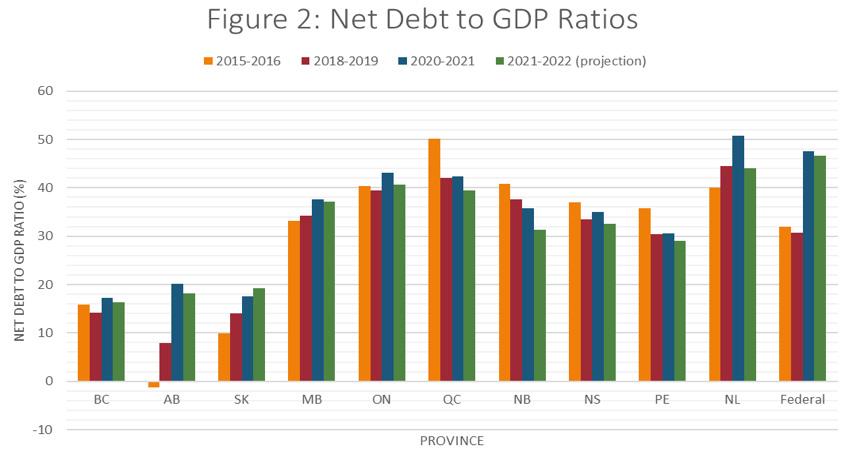
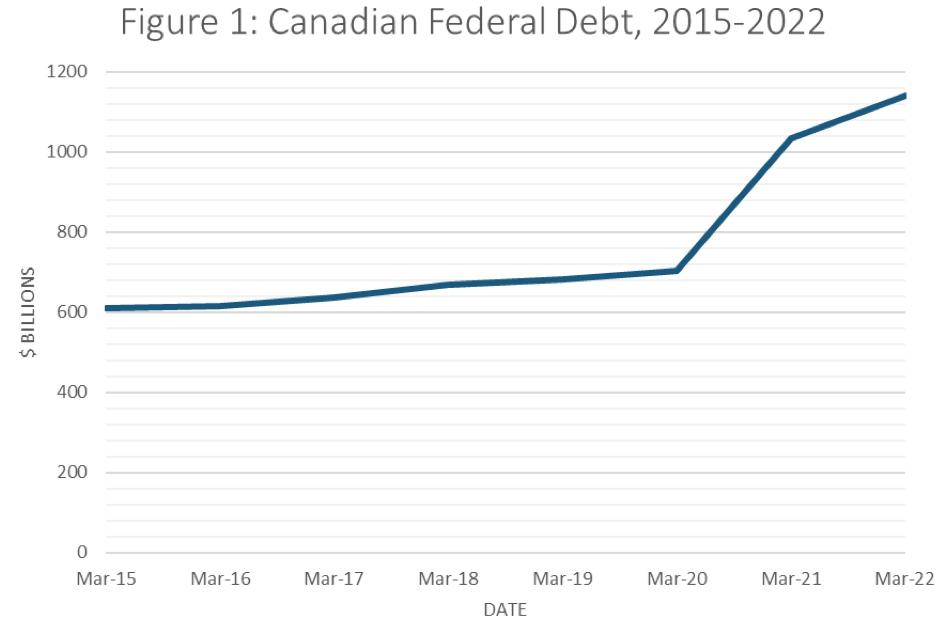 Source: Statistics Canada Table 10-10-0002-01.
Source: RBC Economics, Canadian federal and provincial data tables.
Source: Statistics Canada Table 10-10-0002-01.
Source: RBC Economics, Canadian federal and provincial data tables.
FALL 2022 11
the pandemic’s influence: Alberta, Newfoundland & Labrador, and Ontario in particular (Thanabalasingam and Abdelrahman, 2021).
Adam Smith’s overall negative view of national debt is echoed by many recent studies that warn of the undesirable consequences of growing government debt, including a correlation with negative economic growth, increases in interest rates over the long-term, and decreases in private investment, which challenge the ability of a country to sustain economic productivity (Fuss and Palacios, 2020; Fuss and Lafleur, 2021). These studies have also explained how tax increases have the effect of limiting economic growth. Perhaps the most relevant to Smith’s stance is the point that the more tax revenues are directed towards paying the interest on public debt, the less funding will be available for government social programs such as education, social services, and health care, let alone the possibility of tax cuts (Fuss and Palacios, 2020). As discussed above, Smith was of the opinion that paying off government debt and lowering interest costs was of critical importance, and not to be ignored in favour of other ways to spend money; in reality, there are political pressures on governments, especially during times of crisis such as the recent pandemic, to provide programs and services via debt financing that are unaffordable and unsustainable in the long run.
From the above analysis, it is clear that Adam Smith would have been an advocate for a very different approach to economic policy from the one currently adopted in Canada. According to Smith in The Wealth of Nations, the three duties of the government include:
(1) protection of people from foreign invasion, (2) protection from injustice and oppression from within, and (3) creating and maintaining certain public works and certain institutions, which can never be ones that the private sector would erect and maintain (Smith, 1776; Otteson, 2018). Given the necessity of funding public goods such as health care and other services to protect Canadians from the COVID-19 virus, it is possible that Smith would have viewed a significant portion of the spending that resulted from the pandemic as justifiable. Nevertheless, there should be a more structured plan in place to ensure that the resulting debt is, and will be, financed properly. These necessary fiscal changes may come in the form of spending cuts, tax increases, new taxes, or a combination thereof, whichever is deemed appropriate. Prior to the COVID-19 pandemic, government spending was already arguably too high, as reflected by the high ratios of government expenditure to GDP shown in Figure 3 and also signified by the consistently large budget deficits that have persisted for years. While the global pandemic was admittedly unpredictable, not having balanced budgets prior to the pandemic meant that the governments had less fiscal resources to serve as a financial safety net (akin to Smith’s idea of a sinking fund) to aid in preventing the national debt from climbing to a record high level.
The impact of COVID-19 on the Canadian economy will last for many years to come. Managing this adverse impact is crucial for our country’s way forward. Canada should take Adam Smith’s advice and seek to follow the fiscally prudent tradition influenced by David Hume and Baron de Montesquieu: avoid large national debts when possible, and repay them promptly when they are incurred. In line with this concept, it is high time that the federal and provincial governments implemented more structured economic recovery plans to decrease government debt as the COVID-19 pandemic begins to subside in Canada.
 Source: RBC Economics, Canadian federal and provincial data tables.
Source: RBC Economics, Canadian federal and provincial data tables.
FRASERINSTITUTE.ORG | CANADIAN STUDENT REVIEW12
Allison Knee is currently an undergraduate economics and business student at Memorial University of Newfoundland and Labrador. Her interests focus on the influence of politics, law, and business on the economy, as well as Canadian finance. After undergrad, she hopes to further her education in both law and business.

Acknowledgements
I would like to thank my professor, Dr. Kam Hon Chu for his encouragement, advice, and suggestions at various stages of writing this essay. All errors are, however, mine.
REFERENCES
Bird, R.M. and M. Smart (2006/2015). Public Debt. The Canadian Encyclopedia. <https://www.thecanadianencyclopedia.ca/en/article/public-debt>, as of August 23, 2022.
Canada (2022). Canada Emergency Response Benefit and EI statistics. Government of Canada. <https://www.canada.ca/en/services/benefits/ei/claims-report.html>, as of May 30, 2022.
Fuss, Jake, and Steve Lafleur (2021). The Growing Debt Burden for Canadians: 2021 edition. Fraser Institute. <https://www.fraserinstitute.org/studies/growing-debt-burden-forcanadians-2021>, as of August 23, 2022.
Fuss, Jake, and Milagros Palacios (2020). The Growing Debt Burden for Canadians. Fraser Institute. <https://www.fraserinstitute.org/studies/growing-debt-burden-for-canadians>, as of August 23, 2022.
Organisation for Economic Co-operation and Development [OECD] (2021a). Revenue Statistics - OECD Countries: Comparative Tables. OECD <https://stats.oecd.org/index. aspx?DataSetCode=rev#>, as of August 16, 2022.
Organisation for Economic Co-operation and Development [OECD] (2021b). Government at a Glance -2021 Edition. OECD. <https://stats.oecd.org/Index. aspx?DataSetCode=GOV_2021>, as of August 16, 2022.
Otteson, James (2018). The Essential Adam Smith. Fraser Institute. <https://www.essentialscholars.org/smith>, as of August 23, 2022.
RBC Economics (2022). Canadian Federal and Provincial Fiscal Tables. RBC Economics. <http://www.rbc.com/economics/economic-reports/pdf/canadian-fiscal/prov_fiscal.pdf>, as of June 14, 2022.
Smith, Adam. (1776/1904). An Inquiry into the Nature and Causes of the Wealth of Nations. Fifth edition. Methuen. Statistics Canada (2022). Table 10-10-0002-01: Central Government Debt (x 1,000,000). Custom search. Statistics Canada. <https://www150.statcan.gc.ca/ t1/tbl1/en/tv.action?pid=1010000201&cubeTimeFrame.startMonth=01&cubeTimeFrame.startYear=2015&cubeTimeFrame.endMonth=03&cubeTimeFrame. endYear=2022&referencePeriods=20150101%2C20220301>, as of May 14, 2022.
Thanabalasingam, Sri, and Omar Abdelrahman (2021). Fiscal Stimulus and Elevated Debt: A New Chapter for the Canadian Economy. TD Economics. <https://economics.td.com/fiscalstimulus-debt>, as of August 23, 2022.
FALL 2022 13
THE FISCAL COSTS OF DEBT-FINANCED GOVERNMENT SPENDING
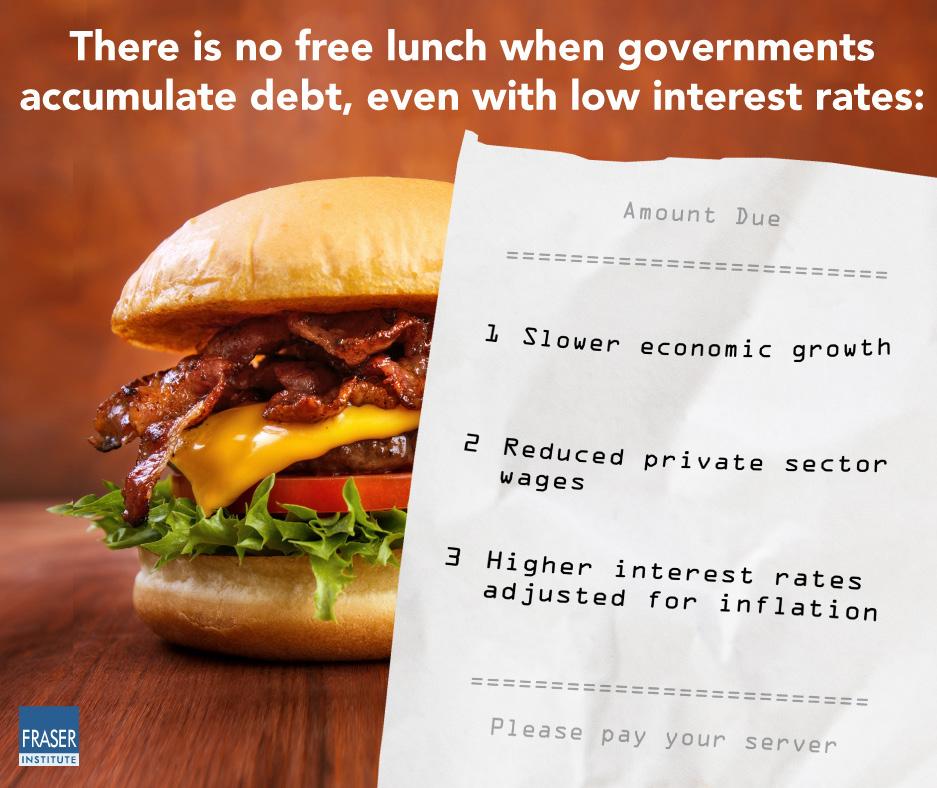
INFOGRAPHIC
READ MORE HERE 14 FRASERINSTITUTE.ORG | CANADIAN STUDENT REVIEW
WHAT HAPPENS WHEN WE DON’T WORK? ADAM SMITH’S PERSPECTIVE ON LABOUR FORCE PARTICIPATION DECLINE
JACK MILLOS
According to Adam Smith, it is the trade between the butcher, baker, and brewer that adds wealth to society. Their specializations allow for improved production and exchange, which gives each the capability to consume more than they could produce on their own. Without all three engaging in production and trade, none can enjoy a full meal. Efficient production of labour creates improvements in societal well-being, as Smith, both a moral philosopher and founding economist, states in An Inquiry into the Nature and Causes of the Wealth of Nations (hereafter shown as WN): “It is not from the benevolence of the butcher, the brewer, or the baker that we expect our dinner, but from their regard to their own self-interest” (WN: 27).
With his principles supported by empirical evidence, Smith asserts that individual aspiration improves social prosperity, demonstrating the importance of the division of labour and employment in advancing society. Writing that “It is the great multiplication of the productions… in consequence of the division of labour… in a well-governed society, that universal opulence which extends itself to the lowest ranks of the people” (WN:23), Smith demonstrates labour’s critical role in ensuring that an economy is a positivesum game.
The good that comes from economic activity is not fuelled by the virtue of the participants, but by the mutual benefits they receive, bettering society as a result. To be more specific, richer countries report higher happiness scores (Ortiz-Ospina, 2013). Through every labourer’s ambition to succeed, “He intends only his own gain, and he is in this, as in many other cases, led by an invisible hand to promote an end
which was no part of his intention” (WN: 456). Without the labourer and his own aspiration, the invisible hand cannot support others. Therefore, to maximize economic growth, motivating employment among non-participating labourers through incentives and good governance is required.
Individuals inherently pursue their own goals easily and efficiently. The objective of these goals, however, is not universal. Differentiated incentives affect the formation and results of the “universal opulence” throughout society. Within any competitive economy, individual ambition serves the common good, as it provides for others to take part in the process, according to Smith’s philosophy (Spencer, 2020). Many in the working-age population want to acquire as much wealth as possible; others want to live a humble life. Either way, they provide to each other the goods and services they need, with the benefits promoting the economy and therefore standards of living and quality of life. Some have no ambition to compete; rather, they aim only to subsist. They have been discouraged from working and have opted out of the workforce, which can be seen in the falling labour force participation rate.
The lower labour force participation rate, initially at 65 percent globally in 1990, has continuously decreased to 59 percent as of 2021 (World Bank, 2022). In the United States, the participation rate dropped from 67.3 to 62.3 percent in the past two decades. The labour force participation rate reached a record low of 60.2 percent in April 2020 on top of the 8.1 percent of workers that became unemployed due to COVID-19 (BLS, 2022).
STUDENT ESSAY WINNER - HIGH SCHOOL FALL 2022 15
The average growth in the US has decreased from an annual rate of 3.5 percent over the past five decades to only 2.0 percent as of late. With US labour force growth previously accounting for 1.3 percent of the average annual growth rate, and recently only representing 0.5 percent, a decline in labour force growth has a detrimental impact on economic growth, demonstrating the importance of labour participation (Dotsey, 2017). After accounting for population growth and aging, two million workers are missing from the US economy (Tüzemen, 2022).
Unfortunately, the situation is similar in Canada. The 68 percent labour force participation rate in 2008 fell to 65.7 percent in 2019, and that number continues to decrease. The growth of the labour force has also been declining in Canada, with projections indicating that the downward trend in labour force growth will continue for decades due to population and participation trends (Cross, 2021). With decreased labour force participation among seniors aged 65 years and older, despite the increasing numbers of this component of the population, overall employment is decreasing significantly. Even with the reopening of the economy sparking renewed participation among the workingage population, senior participation still decreased, leading to a decrease in overall participation as well (Hill, 2022).
Amplified by the economic strain caused by COVID-19, aging and participation trends have caused the labour shortage Canada is currently facing; unfilled positions are at an all-time high as of 2022, exemplifying what a declining labour force participation rate can do to the economy (Statistics Canada, 2022).
Even prior to the pandemic, the labour shortage had caused 40 percent of small and medium sized businesses to have difficulties hiring, which led to existing staff being overworked, production being limited, and reduced revenue growth. The inefficient use of existing labour and the reduced economic activity stemming from it have obstructed operations for Canadian businesses, which is harming everyone (BDC, 2018).
When a foundational input of the economy is not used effectively, reduced output follows. Major
factors driving this are the decrease in participation of seniors, young workers, and men of prime working age (Kreuger, 2017). Only one sixth of the participation rate decline has been attributed to cyclical conditions (CEA, 2014).
The retirement of baby boomers in the US accounts for 1.3 percent of an adjusted 2.8 percent drop in labour force participation from 2007 to 2014, with retirement’s effects on participation likely to continue (Aaronson, 2014). It is not exclusively ageing that causes retirement; barriers for older workers also contribute to the increase in retirees (Gunderson, 2022).
However, 20 percent of the total decline in labour force participation is attributed to workers aged 16 to 24, with this trend taking place over decades. While some economists speculate that enrollment in education may account for this, participation rates for enrolled and unenrolled youths are declining, indicating it is not only increased education causing decreased participation among youth. Moreover, uneducated men are disproportionately backing out of the labour force. Of the labour force drop, 0.6 percent is due to a decrease in youth participation (Aaronson, 2014). Roughly 16 percent of non-participating men of prime working age have opted out of the workforce. Economists hypothesised that a rise in spousal participation and alternative income could explain the decline, but both have been shown to have no significant effect as to why men are not participating (Krueger, 2017).
Rather, increases in transfer payments through programs like disability insurance, unemployment insurance, and other benefits are leading a portion of working-age men to choose to stay out of the workforce (Krueger, 2017). Welfare programs disincentivise employment which leads to a substantial impact on labour supply (Mullen, 2022). Policies that decrease labour force participation have been prominent during the COVID-19 pandemic, with the Canada Recovery Benefit disincentivizing employment (Eisen, 2020).
Like Smith suggests, human beings have a general tendency to achieve their goals in a way that is most efficient for them. If their goal is to live without work,
FRASERINSTITUTE.ORG | CANADIAN STUDENT REVIEW16
transfer payments provide the perfect method to not contribute by rewarding non-participation. Transfer payments disincentivizing labour force participation clearly outline the poor effect of government intervention in the economy. According to Smith, “The natural effort of every individual to better his own condition... is so powerful, that it is alone, and without any assistance, capable of carrying on the society to wealth and prosperity” (WN: 417). Individuals naturally improve their life, which in turn contributes to society, and government aid only hinders the process.
Because income taxes reduce net wages, higher taxation increases non-participation. Furthermore, uncompetitive real wages paired with rising inequality further disincentivize less skilled workers (Krueger, 2017). According to Smith, “No society can surely be flourishing and happy, of which the far greater part of the members are poor and miserable” (WN: 97). To achieve a flourishing and happy society, businesses must pay fair, competitive wages and the government must tax minimally (Kreuger, 2017).
Finally, poor social well-being correlates to nonparticipation in the labour force. Individual health problems, notably caused by poor mental health and drug abuse, are a major source of low-quality social well-being leading to inactive men. Of men not in the labour force, 43 percent said their health was fair or poor compared to 12 percent of employed and 16 percent of unemployed men. The 2010, 2012, and

2013 American Time Use Survey Well-Being Module conducted by US Bureau of Labour Statistics, asked respondents to rate the level of pain they felt daily on a scale of zero to six, with zero meaning no pain and six meaning excruciating.
The pain rating of inactive men was 89 percent higher than that of employed men (Kreuger, 2017). Geographical areas with lower labour participation rates have more opioid prescriptions per capita than others. The opioid crisis is intertwined with reduced labour force participation among men of prime working age. Alarmingly, between 1999 and 2015, opioid use could potentially account for 0.6 percent of the labour force participation decline among men, which is 20 percent of the overall labour force decline in that period. Mental health, disability, and their relation to opioid use—possibly extending to other drugs—are major reasons for the decline in labour force participation, which can be attributed to government failure in legislating medication and maintaining adequate law enforcement of narcotics.
To Smith, it is exclusively the role of the government to protect us from internal threats, external threats, and provide public works that otherwise could not be provided by the private sector. By intervening through transfer payment programs, governments have disrupted the market by taxing more while disincentivizing labour. Furthermore, drug abuse issues—ineffectively dealing with the opioid crisis,
FALL 2022 17
for example—illustrate the government’s failure to protect the person. How the three functions of government have been executed contribute to falling participation rates and the improper use of labour.
In summary, productive powers of labour lead to the improvement of society. Without the effective use of labour, which can be attributed to government failure and non-competitive wages, Smith would say society
is not as successful as it can be. The decline in the labour force participation rate is an inefficient use of a valuable, scarce resource and, more importantly, a moral issue holding society back from reaching an elevated state of real wealth and well-being. Accordingly, action to increase participation in the labour market is required to improve the well being of all.
Prior to entering Neuchâtel Junior College in Switzerland to complete grade 12, Jack Millos was a student at West Point Grey Academy in Vancouver. His interests in social well-being have inspired him to pursue further studies in economics and public policy at university.

REFERENCES
Aaronson, Stephanie, et al. (2014). Labor Force Participation: Recent Developments and Future Prospects. Federal Reserve Board Working Paper 2014-64. <https://doi.org/10.2139/ ssrn.2498005>, as of August 24, 2022.
Bureau of Labor Statistics (2013). Persons with a Disability: Barriers to Employment, Types of Assistance, and Other Labor-Related Issues, May 2012. Government of the United States, Department of Labor.
Business Development Bank of Canada [BDC] (2018). Labour Shortage: Here to Stay. Worker Scarcity in Canada and What Businesses Can Do to Respond. BDC Study (September). <https://www.bdc.ca/en/documents/analysis_research/labour-shortage.pdf>, as of August 24, 2022.
Council of Economic Advisers [CEA] (2014). The Labor Force Participation Rate since 2007: Causes and Policy Implications. Executive Office of the President of the United States. <https:// obamawhitehouse.archives.gov/sites/default/files/docs/labor_force_participation_report.pdf>, as of August 24, 2022.
Council of Economic Advisers [CEA] (2016). The Long-Term Decline in Prime-Age Male Labor Force Participation. Executive Office of the President of the United States. <https:// obamawhitehouse.archives.gov/sites/default/files/page/files/20160620_primeage_male_lfp_cea.pdf>, as of August 24, 2022.
Cross, Philip (2021). The Implications of Slowing Growth in Canada’s Labour Force. Research Bulletin. Fraser Institute. <https://www.fraserinstitute.org/sites/default/files/implications-ofslowing-growth-in-canadas-labour-force.pdf>, as of August 24, 2022.
Dotsey, Michael (2017). Where Is Everybody? The Shrinking Labor Force Participation Rate. Economic Insights 2, 4. Eisen, Ben (2020, November 4). Trudeau Government Creating Harmful Work Disincentives for Many Canadians. Fraser Institute. <https://www.fraserinstitute.org/article/trudeaugovernment-creating-harmful-work-disincentives-for-many-canadians>, as of August 29, 2022.
Gunderson, Morley (2022). Barriers to the Labour Force Participation of Older Workers in Canada. Fraser Institute. <https://fraserinstitute.org/sites/default/files/barriers-to-labourforce-participation-of-older-workers-in-canada.pdf>, as of August 24, 2022.
Hill, Tegan, Alex Whalen, and Milagros Palacios (2022). An Aging Population: The Demographic Drag on Canada’s Labour Market. Fraser Institute. <https://www.fraserinstitute.org/sites/ default/files/an-aging-population-the-demographic-drag-on-canadas-labour-market.pdf>, as of August 24, 2022.
Krueger, Alan B. (2017). Where Have All the Workers Gone? An Inquiry into the Decline of the U.S. Labor Force Participation Rate. Brookings Papers on Economic Activity. Brookings Institution. <https://www.brookings.edu/wp-content/uploads/2017/09/1_krueger.pdf>, as of August 24, 2022.
Ortiz-Ospina, Esteban, and Max Roser (2013/2017). Happiness and Life Satisfaction. Our World in Data, University of Oxford. <https://ourworldindata.org/happiness-and-lifesatisfaction#:~:text=As%20we%20can%20see%2C%20self,have%20higher%20average%20happiness%20scores>, as of August 24, 2022.
Smith, Adam (1776/2007). An Inquiry into the Nature and Causes of the Wealth of Nations. Metalibri. Spencer, Richard (2020). The Public Interest, the Common Good: A Radical Profession? Critical Perspectives on Accounting, volumes 67-68. Elsevier. Statistics Canada (2022, May 26). Payroll Employment, Earnings and Hours, and Job Vacancies, March 2022. The Daily. Government of Canada. <https://www150.statcan.gc.ca/n1/ daily-quotidien/220526/dq220526a-eng.htm>, as of August 24, 2022.
Tüzemen, Didem (2022). How Many Workers Are Truly “Missing” from the Labor Force? KC Fed Economic Bulletin (May 6). Federal Reserve Bank of Kansas City. <https://www. kansascityfed.org/Economic%20Bulletin/documents/8788/EconomicBulletin22Tuzemen0506.pdf>, as of August 24, 2022.
World Bank (2022). Labor Force Participation Rate, Total (% of Total Population Ages 15+) (Modeled ILO Estimate). Data, World Bank (June). <https://data.worldbank.org/indicator/ SL.TLF.CACT.ZS>, as of August 24, 2022.
FRASERINSTITUTE.ORG | CANADIAN STUDENT REVIEW18
PRIVATIZE THE NOVA SCOTIA LIQUOR CORPORATION—IT’S A NO-BRAINER

ALEX WHALEN
Premier Tim Houston’s government in Nova Scotia made headlines recently by reducing the number of Crown corporations focused on economic development from five to two. In announcing the move, the premier pointed to an ongoing review of Crown corporations. As this process unfolds, the decision on one Crown corporation should be a nobrainer—it’s time to privatize the Nova Scotia Liquor Corporation (NSLC).
When asked about rumours that his government may privatize the NSLC earlier this year, Finance Minister Allan MacMaster downplayed the possibility but stopped short of ruling it out completely. Simply put, there are several reasons that Nova Scotians would benefit from a privatized NSLC.
Privatization, which has largely been successful elsewhere, would likely lead to more choice and convenience for consumers. Consider the experience
of Alberta, which privatized the retail portion of liquor sales in the early 1990s. Research has shown that postprivatization, consumers benefited from increased competition with more stores, falling liquor prices, and greater product selection. Crucially, research also finds “no evidence that the residents of Alberta have been exposed to increases in crime or liquor-related offenses as a direct result of privatization.”
As with most monopolies, the NSLC is profitable, having delivered $274.5 million in net income in its most recent fiscal year. Opponents of privatization point to this revenue. However, according to research, the Alberta government did not experience a loss of revenue from privatization and actually received more revenue through increased sales (and additional corporate income taxes from the new private-sector stores).
THE FRASER INSTITUTE BLOG FALL 2022 19
Profits from the sale of the NSLC—in whatever form— could be applied to the province’s debt, which will reach $18.4 billion this year. At this level of debt, government is expected to spend $676 million on interest costs this year alone. Reducing the debt by selling the assets of the NSLC would reduce these costs, which would leave more money for things such as health care and even tax relief.
Moreover, the NSLC has several lines of business including wholesale, distribution, and retail. A breakdown of stores illustrates the lack of privatesector involvement. The NSLC currently operates 108 retail stores and an additional 65 agency stores. By comparison, the NSLC allowed just four private stores to open in 2002 (all in the Halifax Regional Municipality) and has not increased the number since. The kicker? The private sector largely provides better hours, better selection, and more convenience for customers.
And yet, despite these potential benefits, interest groups will continue to resist privatization. For example, the NSGEU, Nova Scotia’s largest union, has
steadfastly opposed privatization of all kinds including a previous proposal to privatize the NSLC in 2013.
Privatization is currently being considered in other provinces including Newfoundland & Labrador following a recommendation from that government’s Economic Recovery Team, which said, “the provincial government should sell all or a majority interest in the Newfoundland and Labrador Liquor Commission.”
A review of the Nova Scotia’s 300 Crown corporations has garnered significant attention in the early days of the Houston government. While decisions on some of those entities may prove to be difficult, privatization of the NSLC would bring more choice for consumers, reduce government debt, and allow the government to focus spending on core priorities. Simply put, it’s a no-brainer.
Alex Whalen is a senior economist with the Fraser Institute and coordinator of the activities of the Atlantic Canada division. Prior to joining the Institute, Alex was vice-president of the Atlantic Institute for Market Studies (AIMS), which merged with the Fraser Institute in 2019. He is a graduate of the Schulich School of Law at Dalhousie University, and the School of Business at the University of Prince Edward Island. He brings prior experience as an entrepreneur and business manager to his work at the Institute. His writing has appeared widely in newspapers including the Globe and Mail, National Post, Chronicle Herald, Telegraph Journal, Calgary Herald, and others.

FRASERINSTITUTE.ORG | CANADIAN STUDENT REVIEW20

BECAUSE IT IS A MONOPOLY, GOVERNMENT BRINGS INEFFICIENCY AND STAGNATION TO MOST THINGS IT RUNS; GOVERNMENT AGENCIES PURSUE THE INFLATION OF THEIR BUDGETS RATHER THAN THE SERVICE OF THEIR CUSTOMERS; PRESSURE GROUPS FORM AN UNHOLY ALLIANCE WITH AGENCIES TO EXTRACT MORE MONEY FROM TAXPAYERS FOR THEIR MEMBERS. YET DESPITE ALL THIS, MOST CLEVER PEOPLE STILL CALL FOR GOVERNMENT TO RUN MORE THINGS AND ASSUME THAT IF IT DID SO, IT WOULD SOMEHOW BE MORE PERFECT, MORE SELFLESS, NEXT TIME. — MATT RIDLEY, THE RATIONAL OPTIMIST: HOW PROSPERITY EVOLVES QUOTE WALL FALL 2022 21FRASERINSTITUTE.ORG | CANADIAN STUDENT REVIEW
A PRIMER ON INFLATION
STEVEN GLOBERMAN
Somewhat over 40 percent of Canada’s current population was born after 1988. Therefore, a substantial proportion of Canadians did not personally experience the prolonged episode of global inflation running from the mid-1970s to the mid-1980s. Indeed, the media has basically ignored inflation over the past 30 years, decades that, until recently, have been marked by low and relatively stable inflation. The sharp increase in the rate of inflation over the past year has brought this public policy issue back to the public’s attention.
While dramatic increases in housing prices across Canada have arguably received the lion’s share of media attention over the past two years, economic issues, including rising prices for food, automobiles, and gasoline have also captured public attention and raised awareness among Canadians of the broadbased nature of recent price increases. In response to the recent and persistent rise in inflation, the Bank of Canada raised its policy interest rate in March 2022 by 25 basis points or a quarter of one percent. It also announced other measures to tighten domestic credit conditions as steps toward restoring relative price stability. A large percentage of Canadians have not faced a prolonged period of rising interest rates, including mortgage rates, which reached double-digit levels in the late 1970s and early 1980s. The possibility that economic conditions might repeat those of the 1970s and 1980s is cause for genuine concern as current inflation conditions are proving to be much worse than monetary authorities and private sector economists foresaw at the start of the COVID-19 epidemic.
As participants in the economy as consumers, investors, labour force participants, and voters, Canadians should be adequately informed about the
important issues surrounding inflation, particularly as it emerges as a public policy issue of pressing concern. These issues include the accuracy and reliability of standard measures of inflation, the causes and consequences of inflation, and the monetary and fiscal policy instruments used to moderate inflation. This primer is meant to provide an overview and analysis of these important issues, hopefully in a manner accessible to non-technical readers.
Inflation refers to a general increase in the prices of goods and services in an economy. The principal measure of inflation is the Consumer Price Index (CPI). Controversy has surrounded the accuracy of the CPI, including concerns about excluded services such as government-funded health care, as well as the need to adjust for changes over time in the quality of the goods and services it includes. However, available studies tend to conclude that corrections made to adjust for quality changes succeed in mitigating any significant upward or downward bias in the CPI measure.
Inflation in Canada averaged 8.1 percent per year from 1971 to 1980 and 6 percent per year from 1981 to 1990. It then averaged 1.88 percent per annum from 1991 to 2020 only to increase to 3.4 percent in 2021. More recently, the annualized rate of inflation reached 5.1 percent in January 2022, the highest rate since 1991.
Inflation occurs when the aggregate demand for goods and services in the economy exceeds the capacity of the economy to meet that demand at the current price level. Aggregate demand is a function of the outstanding money supply and the rate at which the money supply turns over, i.e., the velocity of money. To illustrate, if the outstanding money supply equals $1,000 and the velocity of money equals 2, aggregate
THE FRASER INSTITUTE BLOG
FRASERINSTITUTE.ORG | CANADIAN STUDENT REVIEW22
demand (or aggregate spending) will equal $2,000. Other things constant, an increase in the money supply contributes to an increase in aggregate demand, as does an increase in the velocity of money.
The potential output of an economy is a function of the total number of hours worked and the real output produced per hour worked (also called the average productivity of labour). All else constant, a decrease in the total number of hours worked and/or a decrease in the average productivity of labour will contribute to a decrease in an economy’s potential output.
Empirical evidence supports the relevance of changes in the money supply, changes in velocity, and changes in potential output as determinants of inflation over time. For example, the sharp spike in the price of crude oil in the mid-1970s was an important spur to inflation, while a marked decline in the velocity of money contributed to relative price stability over the past two decades. The growth of the money supply was also an important contributor to inflation in the 1970s and 1980s, and the very rapid growth of the money supply since the outset of the COVID-19 pandemic has certainly contributed to the current inflation problem.
While most economists believe that a low and stable rate of inflation should be the goal of policymakers, there is no agreed-upon optimal rate of inflation. The Bank of Canada has a target for inflation of 2 percent per annum within a band of 1 percent to 3 percent, and the 2 percent per annum policy target is shared by several other central banks. A relatively low and stable rate of inflation enables the price system to play its role of signaling when the output of specific products should be increased while others should be decreased. When prices increase broadly because of inflation, “noise” is introduced into the price signaling system, particularly because inflation
does not cause prices to rise at the same pace in all product markets. Misleading price signals contribute to reduced economic efficiency.
Modest and steady inflation also minimizes the redistribution of income and wealth that result in windfall gains for some and windfall losses for others. In this regard, governments are typically major financial beneficiaries of inflation given that a significant portion of the tax base is not indexed to the rate of inflation. As a result, productive resources are transferred from the private sector to the public sector, which further harms productivity growth.
Monetary policy has been the traditional policy tool to maintain low and stable inflation. Until recently, concerns about slow economic growth following the 2007-2008 financial crisis and the COVID epidemic of 2020 have encouraged central banks to keep real interest rates near zero and to ensure easy credit conditions for borrowers, including governments. As the traditional policy instrument, i.e., the central bank’s lending rate, approached zero, the Bank of Canada and the US Federal Reserve implemented new policy instruments including quantitative easing and forward guidance. The former involves the central bank buying large quantities of government bonds and mortgages to hold on its balance sheet. The latter encompasses regular public announcements by the central bank of its future policy intentions with respect to monetary policy. As it confronts a renewed inflation problem the Bank of Canada has begun to increase its policy interest rate while announcing that it is pausing quantitative easing. Whether the measures to be taken will be sufficiently robust to restore relative price stability is a major question for Canadian businesses and households.
To access the full report click here.
Steven Globerman is a senior fellow and Addington Chair in Measurement at the Fraser Institute, and professor emeritus at Western Washington University. Previously, he held tenured appointments at Simon Fraser University and York University and has been a visiting professor at the University of California, University of British Columbia, Stockholm School of Economics, Copenhagen School of Business, and the Helsinki School of Economics. He earned his BA in economics from Brooklyn College, his MA from the University of California, Los Angeles, and his PhD from New York University .

FALL 2022 23
EXPLORE PUBLIC POLICY ISSUES

WEBINAR RECORDINGS
Our Explore Public Policy Issues webinars are live and on demand. Below are recordings of a few past presentations. To learn more, and to register for our live webinars next semester, visit, visit www.freestudentseminars.org.
The Coddling of the Canadian Mind
Greg Lukianoff

Something has been going wrong on many post-secondary campuses in the last few years. Rates of anxiety, depression, and suicide are rising. How did this happen? This webinar is based on the bestselling book, The Coddling of the American Mind. The book shows how the new problems on campus have their origins in three terrible ideas that have become increasingly woven into our childhood and education: What doesn’t kill you makes you weaker; always trust your feelings; and life is a battle between good people and evil people. These three Great Untruths contradict basic psychological principles about well-being and ancient wisdom from many cultures. Embracing these untruths—and the resulting culture of safetyism—interferes with young people’s social, emotional, and intellectual development. It makes it harder for young adults to navigate the bumpy road of life.
Link to Greg Lukianoff Recording
The Essential Women in Liberty: Jane Jacobs
Lydia Miljan

Since the Covid-19 pandemic some have speculated about the future of cities. With learning, working, and entertainment being conducted in virtual spaces we might ask what is the point of having ourselves organized in places called cities?
Jane Jacobs is as good a place as any to answer that question. She was the author of 9 books, ostensibly about cities, but also about economics, diversity, and social theory. This talk presents an overview of Jacob’s contribution to our understanding of cities and the state.
Link to Lydia Miljan Recording
FRASERINSTITUTE.ORG | CANADIAN STUDENT REVIEW24
CHECK US OUT…
CANADIAN STUDENT REVIEW IS OFFERED FREE TO STUDENTS ACROSS CANADA.

TO RECEIVE A SUBSCRIPTION, OR TO WRITE TO US ABOUT ARTICLES YOU READ IN THIS PUBLICATION, E-MAIL: STUDENT@FRASERINSTITUTE . ORG
CLICK HERE TO RECEIVE A SUBSCRIPTION TO OR INFORMATION ABOUT:
CANADIAN STUDENT REVIEW: A COLLECTION OF ARTICLES FROM BOTH ECONOMISTS AND STUDENTS.
EVENTS: ATTEND ONE OF OUR “EXPLORE PUBLIC POLICY ISSUES” SEMINARS ACROSS CANADA
FRASER INSIGHT: A FRASER INSTITUTE REVIEW OF PUBLIC POLICY IN THE UNITED STATES.
FRASER UPDATE: THE NO. 1 SOURCE FOR FRASER INSTITUTE NEWS; CONVENIENT AND CONCISE.
VOLUNTEERING: EMAIL STUDENT@FRASERINSTITUTE.ORG FOR FURTHER INFORMATION ABOUT VOLUNTEER OPPORTUNITIES
Get daily updates from @FraserInstitute
Like us on Facebook through our website or visit: facebook .com/EducationPrograms
Canadian STUDENT REVIEW

